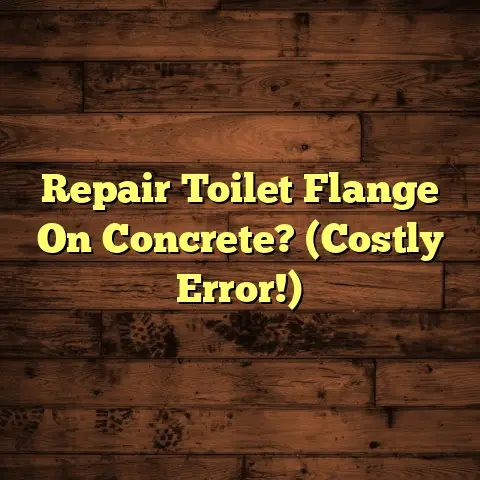Bamboo Floor Glue Fix (3-Step Residue Removal!)
Ever feel like you’re battling a ghost?
I’m talking about that stubborn glue residue on your beautiful bamboo floor.
It’s like a lingering shadow, refusing to fade away.
Just as shadows can obscure the beauty of a sunlit room, glue residue can detract from the elegance of your bamboo flooring.
But don’t worry, I’m here to help you chase away those shadows!
As a flooring contractor with years of experience, I’ve seen it all, and I’m going to share my 3-step guide to get your bamboo looking its absolute best.
Section 1: Understanding Bamboo Flooring and Glue Residue
Subsection 1.1:
The Beauty and Benefits of Bamboo Flooring
Let’s face it, bamboo flooring is gorgeous.
It’s not just about aesthetics; it’s an eco-conscious choice too.
Bamboo is a rapidly renewable resource, making it a sustainable option for modern homes.
Plus, it’s incredibly durable.
I’ve installed bamboo in high-traffic areas, and it holds up remarkably well.
According to the National Association of Home Builders, bamboo flooring can last from 20 to 50 years with proper care.
That’s a pretty good return on investment, right?
Subsection 1.2:
Common Causes of Glue Residue
So, where does this pesky glue residue come from?
It usually pops up during installation, especially if the original installer wasn’t as careful as they should have been.
Or, if you’ve removed old flooring that was glued down, you’re likely to encounter it.
There are different types of adhesives used, from pressure-sensitive adhesives (PSAs) to stronger epoxy-based ones.
Each type has its own set of challenges when it comes to removal.
Sometimes, the adhesive reacts with the finish on the bamboo, creating a stubborn bond that’s hard to break.
I’ve seen cases where moisture or temperature changes can also affect the adhesive, making it even more difficult to remove cleanly.
Section 2: The Importance of Proper Residue Removal
Subsection 2.1:
Impact on Aesthetics and Maintenance
Glue residue isn’t just an eyesore; it can actually affect the long-term maintenance of your floor.
It attracts dirt and grime like a magnet, making it harder to keep your bamboo clean.
Plus, improper removal can lead to damage or discoloration.
I’ve seen folks try to scrape it off with a metal tool, only to scratch the surface.
Ouch!
That’s why it’s crucial to use the right techniques and gentle methods that won’t harm the bamboo.
Subsection 2.2: Safety Considerations
Before we dive into the removal process, let’s talk safety.
Some adhesive removers contain harsh chemicals that can be harmful if not used properly.
Always wear gloves, a mask, and eye protection when working with these products.
And make sure you have good ventilation to avoid inhaling any fumes.
I’ve had my share of close calls, and trust me, it’s better to be safe than sorry!
Section 3: The 3-Step Residue Removal Process
Alright, let’s get down to business.
Here’s my tried-and-true 3-step process for removing glue residue from bamboo flooring:
Step 1: Gather Your Tools and Materials
First things first, gather your arsenal.
You’ll need:
- A plastic scraper or putty knife: Avoid metal, as it can scratch the bamboo.
- Warm water: This is your primary softening agent.
- Vinegar or a specialized adhesive remover: Vinegar is a natural option; adhesive remover is for tougher cases.
- Soft cloths or towels: Microfiber cloths work great for wiping.
- Protective gear (gloves, mask, goggles): Safety first!
I always keep a well-stocked toolkit, and these are the essentials for any glue residue removal project.
Step 2: Initial Residue Softening
The key to successful removal is softening the residue first.
Here’s how:
- Mix your solution:
For a mild case, mix equal parts warm water
and white vinegar in a spray bottle.
For tougher residue, use a specialized adhesive remover according to the manufacturer’s instructions. - Apply the solution:
Spray the affected area generously with
your chosen solution.
Make sure the residue is thoroughly soaked. - Let it sit:
Allow the solution to sit for 10-15 minutes.
This gives it time to penetrate and soften the glue.
For stubborn cases, you might need to repeat this process a few times.
I often use a damp cloth soaked in warm water and place it over the residue to keep it moist during the softening process.
Step 3: Scraping and Cleaning
Now for the fun part!
- Scrape gently:
Using your plastic scraper or putty knife,
gently scrape off the softened residue.
Hold the scraper at a low angle to avoid scratching the bamboo.
Work in small sections, and be patient.
Don’t force it! - Wipe clean: After scraping, wipe down the area with a clean, damp cloth to remove any remaining residue or solution.
- Repeat if necessary: If you still see stubborn spots, repeat steps 2 and 3 until the residue is completely gone.
I find that using a circular motion with the scraper helps to lift the residue without damaging the bamboo.
Section 4: Post-Removal Care and Maintenance
Subsection 4.1: Inspecting the Floor After Removal
Once you’ve removed the glue residue, take a close look at your floor.
Check for any remaining residue or damage.
If you see any scratches, you can try using a bamboo floor touch-up kit to repair them.
I always recommend inspecting the area in good lighting to catch any imperfections.
Subsection 4.2:
Regular Maintenance Tips for Bamboo Flooring
To keep your bamboo floor looking its best and prevent future issues, follow these maintenance tips:
- Sweep or vacuum regularly: This removes dirt and debris that can scratch the surface.
- Use a damp mop: Clean your floor with a damp mop and a pH-neutral cleaner specifically designed for bamboo flooring.
- Avoid harsh chemicals: Never use abrasive cleaners, bleach, or ammonia, as they can damage the finish.
- Use floor protectors: Place felt pads under furniture legs to prevent scratches and dents.
- Control humidity: Bamboo is sensitive to humidity, so maintain a consistent humidity level in your home to prevent warping or cracking.
I often advise my clients to invest in a good quality bamboo floor cleaner and follow the manufacturer’s instructions carefully.
Conclusion
Removing glue residue from bamboo flooring can be a bit of a challenge, but it’s definitely doable with the right tools and techniques.
By following my 3-step process and practicing good maintenance habits, you can restore the beauty of your bamboo floors and enjoy them for years to come.
Just as light can chase away shadows, your efforts will leave a bright and inviting space.
So, go ahead and tackle that glue residue.
You’ve got this!





